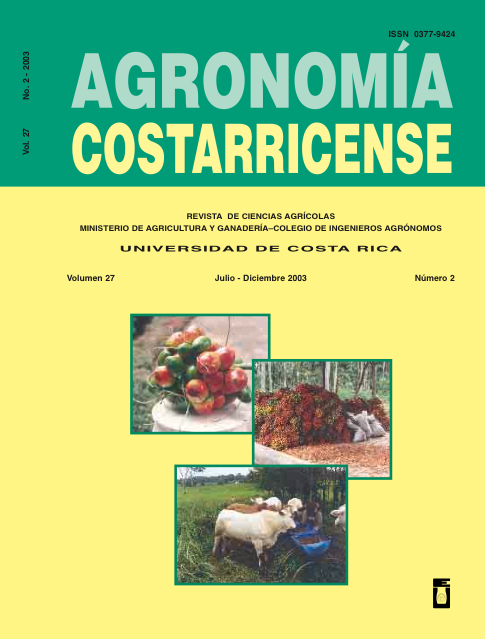Abstract
Growth curves, as well as total and percent nutrient absorption curves, were generated for two red-grain bean varieties, Bribri and Sacapobres; the purpose was to improve conventional fertilization recommendations, on amount and timing of application, that are presently in use in Costa Rica’s southern bean region. Five plants of each variety were sampled every 2 weeks, weighed and analyzed according to type of tissue (roots, top, pods). Plants grew on a soil of good fertility, with moderate P and Zn levels (8 and 2.3 mg l-1 in Modified Olsen, respectively). For both varieties, elements taken up in greater amounts were K and N, followed by Ca and then by P and Mg. In the case of the Bribri variety, for a density of 156000 plants ha-1 and a dry weight yield of 3.5 t pods ha-1 (commercial grain yield of 1.2 t ha-1), extraction totals, in kg ha-1, corresponded to156 N, 24 P, 222 K, 117 Ca, 26 Mg, 1 Fe, 0.3 Cu, 0.7 Zn and 0,6 Mn. Of these values, 37%, 52%, 39%, 11% and 32% of N, P, K, Ca and Mg, respectively, were extracted directly by pods. As for Sacapobres, for a density of 178500 plants ha-1 and a yield of 2.9 t pods ha-1 (0.97 t ha-1 commercial grain yield), extraction totals, in kg ha-1, were: 191 N, 25 P, 189 K, 143 Ca, 33 Mg, 1.3 Fe, 0.1 Cu, 0.4 Zn and 0.8 Mn. Percentages corresponding to pods harvested were 33%, 40%, 34%, 7% and 19% for N, P, K, Ca and Mg, respectively. The most recycled nutrient in crop residues is Ca. In general, recommended doses in the southern region of Costa Rica (3-5 50-kg bags of 10-30-10 ha-1) fulfill the crop needs of these varieties when P and K levels are adequate. As for the stages of maximum nutrient absorption, for both varieties, over 60% of the N, P and K taken up is absorbed between days 30 and 45; thus, it would be advisable to fraction fertilizer application in 2 stages: at 0-7 days and at 22-30 days.
##plugins.facebook.comentarios##

This work is licensed under a Creative Commons Attribution-NonCommercial-NoDerivatives 4.0 International License.
Copyright (c) 2024 Agronomía Costarricense


